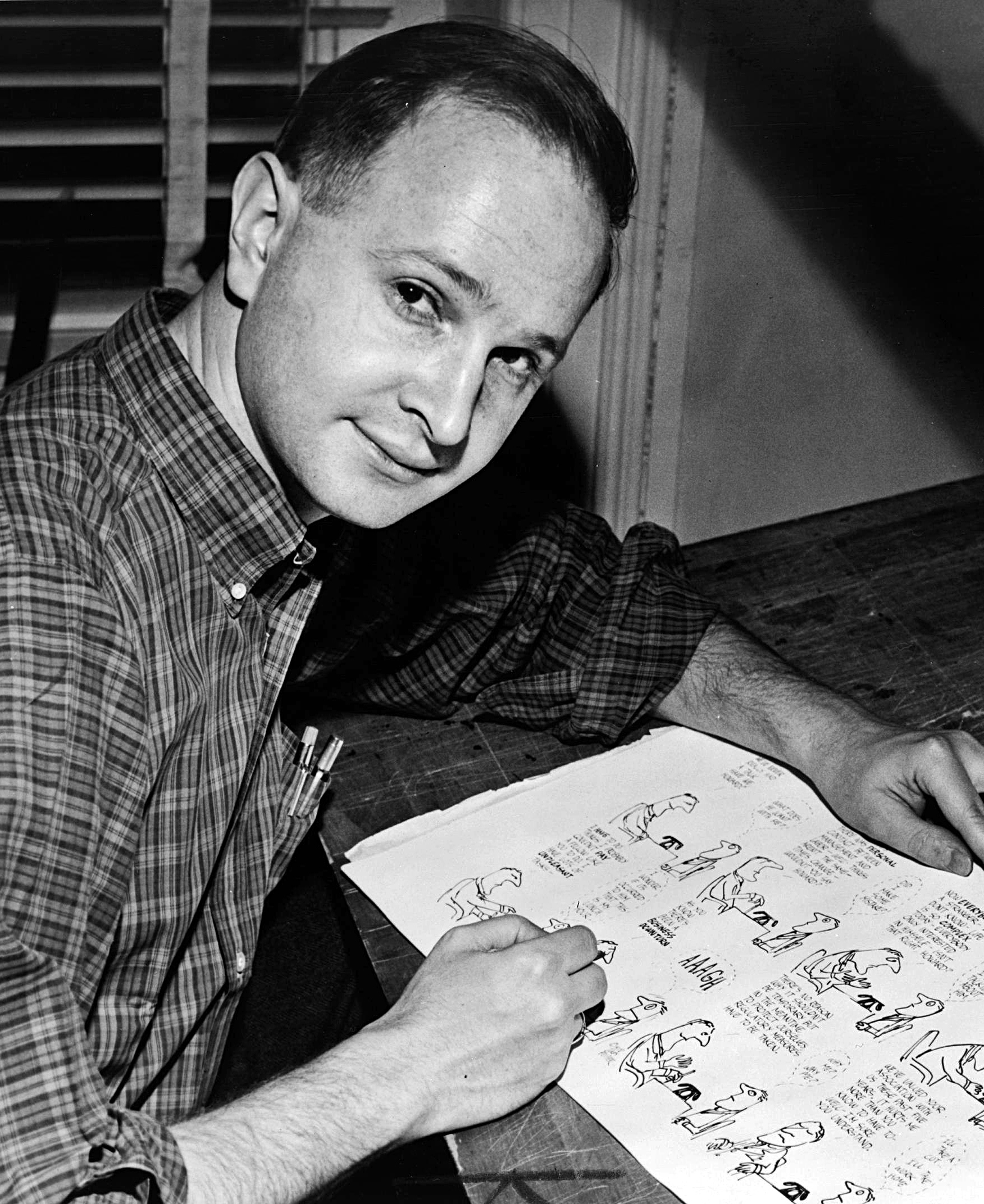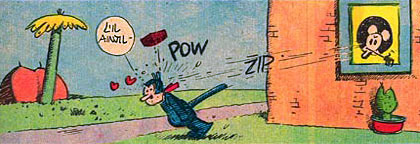|
Polly And Her Pals
''Polly and Her Pals'' is an American comic strip, created by cartoonist Cliff Sterrett, which ran from December 4, 1912, until December 7, 1958. It is regarded as one of the most graphically innovative strips of the 20th century. It debuted as ''Positive Polly'' on December 4, 1912, in William Randolph Hearst's newspapers, initially the ''New York Journal'', and was later distributed by King Features Syndicate. The title changed to ''Polly and Her Pals'' on January 17, 1913. Characters and story *Polly Perkins – The nominal star of the strip was a pretty young girl, a flirtatious child of the Suffragette movement and a precursor of the Jazz Age 1920s flappers. Over time, the center of the action changed from Polly to those around her, and thus the title changed to ''Polly and Her Pals''—though the "pals" were in fact members of her family: her parents and cousins. *Paw ( Sam'l or Sambo) Perkins – Polly's excitable father, the main character and real star of the strip. *M ... [...More Info...] [...Related Items...] OR: [Wikipedia] [Google] [Baidu] |
Blondie (comic Strip)
''Blondie'' is an American comic strip created by cartoonist Chic Young. The comic strip is distributed by King Features Syndicate, and has been published in newspapers since September 8, 1930. The success of the strip, which features the eponymous blonde and her sandwich-loving husband, led to the long-running '' Blondie'' film series (1938–1950) and the popular '' Blondie'' radio program (1939–1950). Chic Young wrote and drew ''Blondie'' until his death in 1973, when creative control passed to his son Dean Young. A number of artists have assisted on drawing the strip over the years, including Alex Raymond, Jim Raymond, Paul Fung Jr., Mike Gersher, Stan Drake, Denis Lebrun, Jeff Parker, and (since 2005) John Marshall. Despite these changes, ''Blondie'' has remained popular, appearing in more than 2,000 newspapers in 47 countries and translated into 35 languages. From 2006 to 2013, ''Blondie'' had also been available via email through King Features' DailyINK servic ... [...More Info...] [...Related Items...] OR: [Wikipedia] [Google] [Baidu] |
Jules Feiffer
Jules Ralph Feiffer (born January 26, 1929)''Comics Buyer's Guide'' #1650; February 2009; Page 107 is an American cartoonist and author, who was considered the most widely read satirist in the country. He won the Pulitzer Prize in 1986 as North-America's leading editorial cartoonist, and in 2004 he was inducted into the Comic Book Hall of Fame. He wrote the animated short ''Munro'', which won an Academy Award for Best Animated Short Film in 1961. The Library of Congress has recognized his "remarkable legacy", from 1946 to the present, as a cartoonist, playwright, screenwriter, adult and children's book author, illustrator, and art instructor. When Feiffer was 17 (in the mid-1940s) he became assistant to cartoonist Will Eisner. There he helped Eisner write and illustrate his comic strips, including ''The Spirit''. In 1956 he became a staff cartoonist at ''The Village Voice'', where he produced the weekly comic strip titled ''Feiffer'' until 1997. His cartoons became nationally sy ... [...More Info...] [...Related Items...] OR: [Wikipedia] [Google] [Baidu] |
Art Deco
Art Deco, short for the French ''Arts Décoratifs'', and sometimes just called Deco, is a style of visual arts, architecture, and product design, that first appeared in France in the 1910s (just before World War I), and flourished in the United States and Europe during the 1920s and 1930s. Through styling and design of the exterior and interior of anything from large structures to small objects, including how people look (clothing, fashion and jewelry), Art Deco has influenced bridges, buildings (from skyscrapers to cinemas), ships, ocean liners, trains, cars, trucks, buses, furniture, and everyday objects like radios and vacuum cleaners. It got its name after the 1925 Exposition internationale des arts décoratifs et industriels modernes (International Exhibition of Modern Decorative and Industrial Arts) held in Paris. Art Deco combined modern styles with fine craftsmanship and rich materials. During its heyday, it represented luxury, glamour, exuberance, and faith in socia ... [...More Info...] [...Related Items...] OR: [Wikipedia] [Google] [Baidu] |
Krazy Kat
''Krazy Kat'' (also known as ''Krazy & Ignatz'' in some reprints and compilations) is an US, American newspaper comic strip, by cartoonist George Herriman, which ran from 1913 to 1944. It first appeared in the ''New York Journal-American, New York Evening Journal'', whose owner, William Randolph Hearst, was a major booster for the strip throughout its run. The characters had been introduced previously in a side strip with Herriman's earlier creation, ''The Dingbat Family''. The phrase "Krazy Kat" originated there, said by the mouse by way of describing the cat. Set in a dreamlike portrayal of Herriman's vacation home of Coconino County, Arizona, ''Krazy'' mixture of offbeat surrealism, innocent playfulness and poetic, idiosyncratic language has made it a favorite of comics aficionados and art critics for more than 80 years.Shannon.McDonnell/O'Connell/De Havenon 26. The strip focuses on the curious relationship between a guileless, carefree, simple-minded cat named Krazy and a sho ... [...More Info...] [...Related Items...] OR: [Wikipedia] [Google] [Baidu] |
Library Of Congress
The Library of Congress (LOC) is the research library that officially serves the United States Congress and is the ''de facto'' national library of the United States. It is the oldest federal cultural institution in the country. The library is housed in three buildings on Capitol Hill in Washington, D.C.; it also maintains a conservation center in Culpeper, Virginia. The library's functions are overseen by the Librarian of Congress, and its buildings are maintained by the Architect of the Capitol. The Library of Congress is one of the largest libraries in the world. Its "collections are universal, not limited by subject, format, or national boundary, and include research materials from all parts of the world and in more than 470 languages." Congress moved to Washington, D.C., in 1800 after holding sessions for eleven years in the temporary national capitals in New York City and Philadelphia. In both cities, members of the U.S. Congress had access to the sizable collection ... [...More Info...] [...Related Items...] OR: [Wikipedia] [Google] [Baidu] |
Rick Marschall
Richard "Rick" Marschall (born February 3, 1949) Miller, John Jackson"Comics Industry Birthdays" ''Comics Buyer's Guide'', June 10, 2005. Accessed January 10, 2011. . is a writer/editor and comic strip historian, described by ''Bostonia'' magazine as "America's foremost authority on pop culture." Marschall has served as an editor for both Marvel and Disney comics, plus several syndicates. Work Marschall has written and edited more than 62 books on cultural topics, including the history of comics, television and country music. He has documented the history of comic strips in two magazines he edited: ''Nemo, the Classic Comics Library'' and '' Hogan's Alley''. For Marvel, he founded the slick graphic story magazine ''Epic Illustrated''. He edited comic strips (''Peanuts'', ''BC'', ''Dick Tracy''), scripted for graphic novels and animated cartoons (''ThunderCats'') and edited a book with Dr. Seuss. Marschall has taught creative writing at the Summer Institute for the Gifted at Bryn ... [...More Info...] [...Related Items...] OR: [Wikipedia] [Google] [Baidu] |
Interwar Period
In the history of the 20th century, the interwar period lasted from 11 November 1918 to 1 September 1939 (20 years, 9 months, 21 days), the end of the World War I, First World War to the beginning of the World War II, Second World War. The interwar period was relatively short, yet featured many significant social, political, and economic changes throughout the world. Petroleum-based energy production and associated mechanisation led to the prosperous Roaring Twenties, a time of both social mobility and economic mobility for the middle class. Automobiles, electric lighting, radio, and more became common among populations in the developed world. The indulgences of the era subsequently were followed by the Great Depression, an unprecedented worldwide economic downturn that severely damaged many of the world's largest economies. Politically, the era coincided with the rise of communism, starting in Russia with the October Revolution and Russian Civil War, at the end of World War I ... [...More Info...] [...Related Items...] OR: [Wikipedia] [Google] [Baidu] |
Bill Blackbeard
William Elsworth Blackbeard (April 28, 1926 – March 10, 2011), better known as Bill Blackbeard, was a writer-editor and the founder-director of the San Francisco Academy of Comic Art, a comprehensive collection of comic strips and cartoon art from American newspapers. This major collection, consisting of 2.5 million clippings, tearsheets and comic sections, spanning the years 1894 to 1996, has provided source material for numerous books and articles by Blackbeard and other researchers. Biography Born in Lawrence, Indiana, Blackbeard spent his childhood in this rural town northeast of Indianapolis. His grandfather ran a service station; his father, Sydney Blackbeard, was an electrician, and his mother, Thelma, handled the bookkeeping for Sydney's business. When he was eight or nine, the family moved to Newport Beach, California, where he attended high school. During World War II, Blackbeard served with the 89th Cavalry Reconnaissance Squad, 9th Army, in France, Belgium and Ger ... [...More Info...] [...Related Items...] OR: [Wikipedia] [Google] [Baidu] |
Al Capp
Alfred Gerald Caplin (September 28, 1909 – November 5, 1979), better known as Al Capp, was an American cartoonist and humorist best known for the satirical comic strip ''Li'l Abner'', which he created in 1934 and continued writing and (with help from assistants) drawing until 1977. He also wrote the comic strips ''Abbie an' Slats'' (in the years 1937–45) and ''Long Sam'' (1954). He won the National Cartoonists Society's Reuben Award in 1947 for Cartoonist of the Year, and their 1979 Elzie Segar Award, posthumously for his "unique and outstanding contribution to the profession of cartooning". Capp's comic strips dealt with urban experiences in the northern states of the USA until the year he introduced "Li'l Abner". Although Capp was from Connecticut, he spent 43 years writing about the fictional Southern town of Dogpatch, reaching an estimated 60 million readers in more than 900 American newspapers and 100 more papers in 28 countries internationally. M. Thomas Inge says ... [...More Info...] [...Related Items...] OR: [Wikipedia] [Google] [Baidu] |
George Herriman
George Joseph Herriman III (August 22, 1880 – April 25, 1944) was an American cartoonist best known for the comic strip ''Krazy Kat'' (1913–1944). More influential than popular, ''Krazy Kat'' had an appreciative audience among those in the arts. Gilbert Seldes' article "The Krazy Kat Who Walks by Himself" was the earliest example of a critic from the high arts giving serious attention to a comic strip. ''The Comics Journal'' placed the strip first on its list of the greatest comics of the 20th century. Herriman's work has been a primary influence on cartoonists such as Elzie C. Segar, Will Eisner, Charles M. Schulz, Robert Crumb, Art Spiegelman, Bill Watterson, and Chris Ware. Herriman was born in New Orleans, Louisiana, to mixed-race Creole parents, and grew up in Los Angeles. After he graduated from high school in 1897, he worked in the newspaper industry as an illustrator and engraver. He moved on to cartooning and comic strips—a medium then in it ... [...More Info...] [...Related Items...] OR: [Wikipedia] [Google] [Baidu] |

_interior.jpg)




